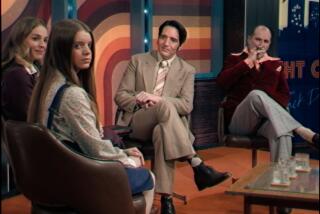Flip Wilson, a pioneer in prime time
Though his time in the national spotlight amounted to only about a decade, Clerow “Flip” Wilson was one of the great comic voices of the 20th century, a compact fireball whose early-1970s NBC variety series embedded characters such as the Reverend Leroy of the Church of What’s Happening Now and Geraldine Jones (a self-assured bundle of sass whose catchphrases were “The devil made me do it” and “What you see is what you get”) in the national consciousness.
As portrayed in Kevin Cook’s new and overdue biography, “Flip: The Inside Story of TV’s First Black Superstar” — which nicks its subtitle from a 1972 Time magazine cover story — Wilson was a more troubled person than his easy and attractive onstage demeanor would suggest. But he was also a more serious and committed one, who studied comedy like a science and performed it as an art. Part of the first wave of black comedians to break the color line, he arrived during the sociocultural crack in time we call the mid-’60s. He straddled that crack for a while, and then it swallowed him.
Before his career-making “Tonight Show” debut, in August 1965, he had spent a decade crisscrossing the country, playing mostly to black crowds. But it was television, culminating in “The Flip Wilson Show,” that made him a household name. “A show hosted by a black had never been accepted,” Wilson said in a 1972 interview for Penthouse magazine, “so the first time that knob’s turned on, people are judging against all they have ever been taught. I may have been the first black in the house.”
By attracting 40 million viewers a week to a show that was, its many white guests notwithstanding, unreservedly black in its tone and rhythms, Flip was in himself revolutionary. And the fully embodied Geraldine, such a successful character that she eventually became a bit of a millstone around his neck, was also radical in her way — “liberated,” Wilson called her. “She may not project the image of a refined, sophisticated lady,” he said, “but she’s honest, she’s frank, she’s affectionate.”
Wilson came out of a difficult Jersey City, N.J., childhood, spent largely in foster homes from which he repeatedly ran away; eventually, he escaped into the Air Force where he began performing. Cook offers an intriguing glimpse into black nightlife in mid-’50s California, where Wilson got his professional start, in San Francisco and the working-class rooms of the San Joaquin Valley. He was older than both Bill Cosby, whose success preceded his (and of which, according to “Flip,” he was jealous), and Richard Pryor, whom he hired as a writer-performer for “The Flip Wilson Show. “ Pryor paid him back by calling him “NBC’s house Negro.”
He was, as Lily Tomlin calls him here, “a transitional figure. He got some flak for not being quote-unquote militant enough, but you have to be who you are, or it won’t work.” A uniter in an age when taking sides was soberly demanded, Wilson stayed committed first to the laugh.
At home, he was a serial adulterer through two marriages and many more relationships. (He never wed the mother of his children, whose custody he eventually gained.) And there had always been drugs in his life, mostly marijuana, which his kids would clean and roll at a kitchen-table assembly line — but also cocaine.
Cook wisely does not make this a story of a Life Destroyed by Narcotics. Still, they might have had something to do with the creeping paranoia that colored his later life; Wilson would sometimes frisk visitors, and at one party, he had some guests take a lie detector test to learn if they had ever stolen from him.
Wilson died of liver cancer in 1998 after what amounted to a long semi-retirement, financially secure if not always content. (One fascinating return, his 1983 hosting of “Saturday Night Live,” gets a only a paragraph here.) He was only 40 when, in 1974, he walked away from “The Flip Wilson Show” in expectation of its cancellation, yet old enough in the terms of his work: Not only were younger, supposedly hipper comics coming up through the door he had helped open, but “Flip Wilson” arrived in the twilight of TV variety. Its slide from the top was inevitable.
A former editor in chief of Golf Magazine, Cook has written most notably about sports. (His last book was the well-received “Titanic Thompson: The Man Who Bet on Everything.”) But he does well with show business and locates his subject within his rapidly changing times. If he sometimes skims where context is called for, he has written an engaging story, more anecdote than analysis, that flows easily and doesn’t bog down in extraneous facts related just for the sake of his knowing them. If a single “real” Wilson never quite coheres, that is how he seems to have appeared to the people who actually knew him.
Flip
The Inside Story of TV’s First Black Superstar
Kevin Cook
Viking: 256 pp., $26.95
More to Read
Sign up for our Book Club newsletter
Get the latest news, events and more from the Los Angeles Times Book Club, and help us get L.A. reading and talking.
You may occasionally receive promotional content from the Los Angeles Times.







